
Ducati’s Monster Aims To Steal The Triumph Street Triple RS’s...
- Jan 28, 2022
- Views : 8515

The undisputed king of middleweight nakeds so far has to be the Triumph Street Triple. It has been ruling the roost for years, wowing audiences with its handling finesse and focus. The RS trim is the epitome of the Street Triple legacy, combining near-superbike levels of equipment with handling that begs for a race track and an almost Moto2-ready engine. However, the king is aging a bit. It has been five years since the 765 series arrived and slightly over two since the last update.
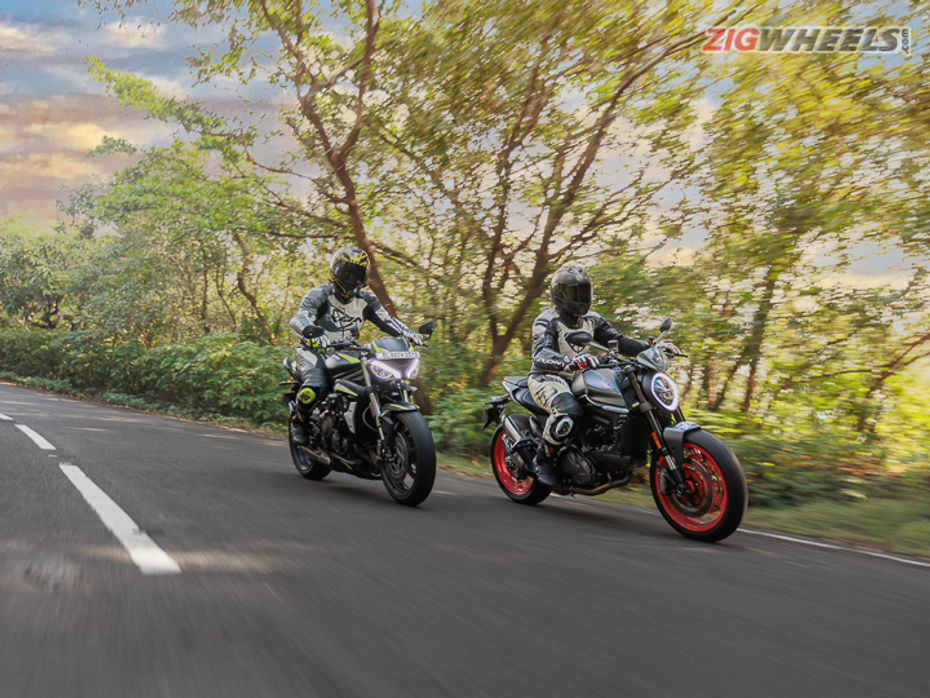
On the other hand, Ducati can claim to own the segment. After all, before there were Dukes and Street Triples, it was Ducati who created this segment with the birth of the Monster almost three decades ago. However, the Monster legacy waned in the last few years, but there’s a dashing new Monster in town, and it wants its crown back.
Will it succeed? Does the king have to worry? Or has the Bolognese superstar missed a spot?
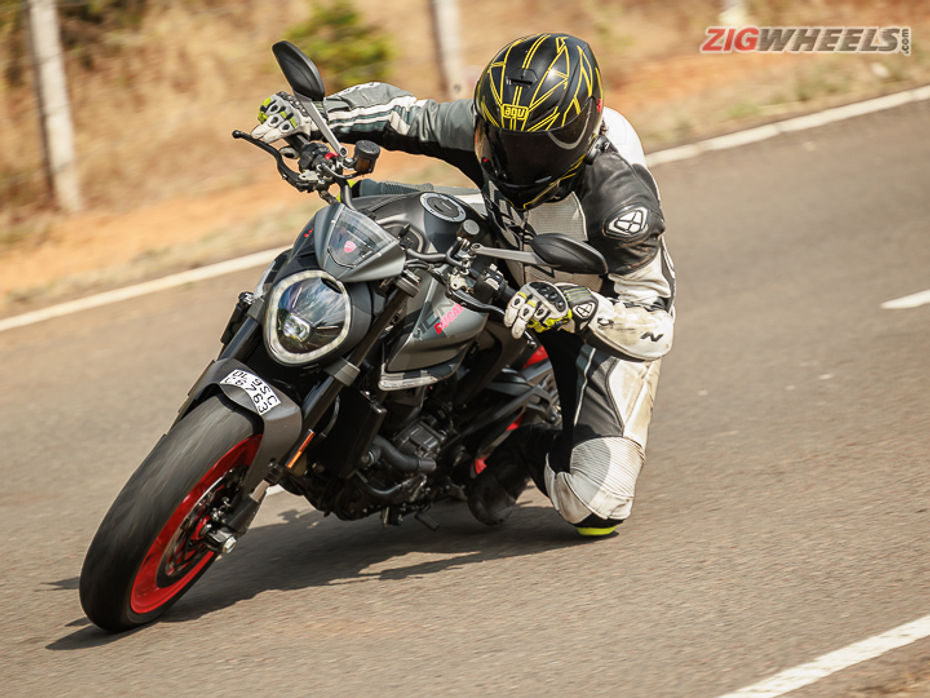
The King’s Backyard
When we got our hands on the two bikes at our HQ, we had to rush to our favourite set of nearby twisties. And even though the differences were stark, we never could’ve believed just how good the new Monster is, because it is running the Street Triple really, really close.
What blew us away at the first ride and continued to do so during the test duration was just how fun and easy it is to hustle the Ducati. The Monster has this boyish charm about it, eager to show how simple things need to be. It coaxes you, welcomes you to take the corners at your own pace. Its welcoming nature feels very reassuring, a great attribute for a motorcycle for those buyers who are stepping into the world of large capacity motorcycles.
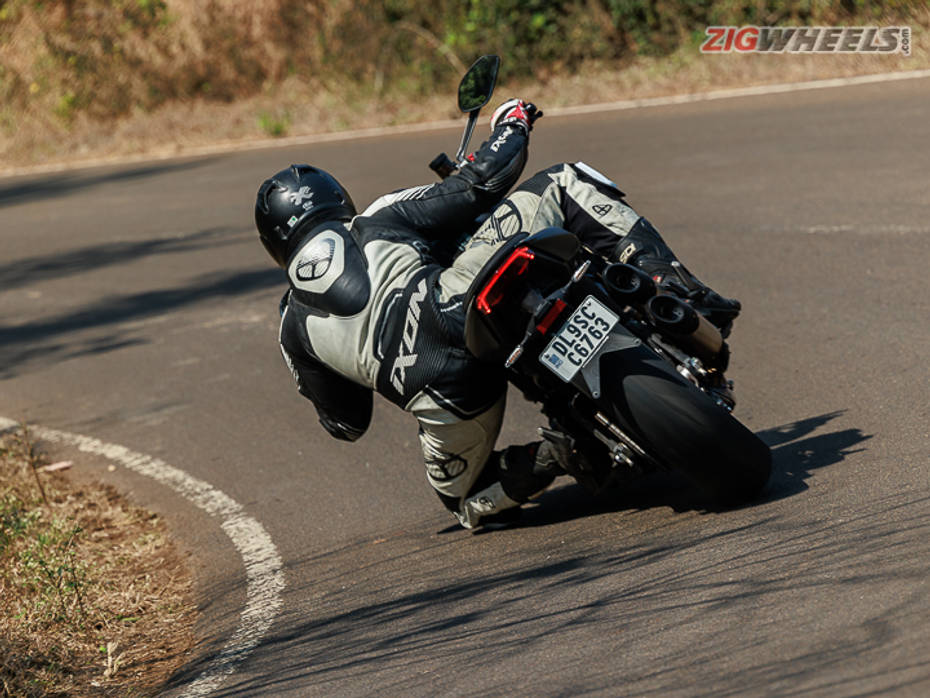
You sit in the bike here, rather than on it, making it an easy space to start with. The bars feel nice and wide. And it is very easy to direct where you want to put the Monster in the corner. It simplifies the cornering procedure by a great extent, making the rider feel settled all throughout.
Plus, you don’t have to proceed with too much caution for fear of a pothole or bump that you might encounter around a blind corner. The suspension’s suppleness takes care of the bumps, never unsettling the bike and thereby the rider’s rhythm.
Having said that, an experienced hand will find the threshold of the Monster pretty soon. Blame it on the relatively simpler front suspension as it tends to make the front end a bit flighty and loose when you start pushing hard.
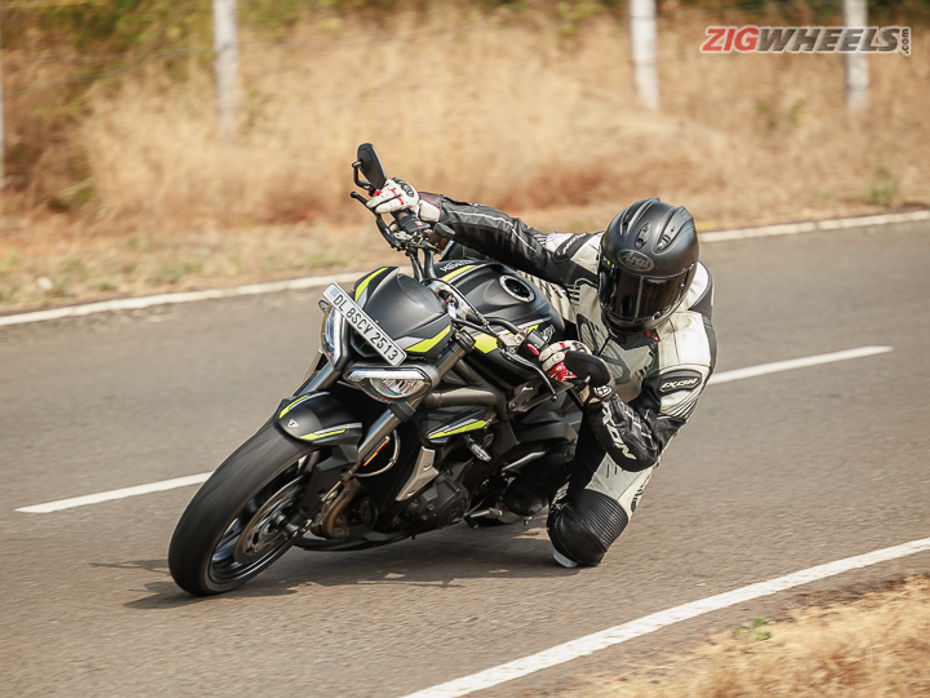
And that’s precisely the point where the Street Triple shows who’s the daddy. It feels like the RS is made for one thing and one thing only: improving lap times. Out in the twisties, it demands you get your markers right, straddle the bike well, focus on everything that’s happening around you; and once you do, you’re rewarded with great lean angles.
Credit must be given to the twin spar aluminium frame that Triumph has been fine-tuning for years. It might feel the larger of the two bikes but it has a tighter rake and shorter wheelbase of the two. And yet, it feels poised and controlled, rarely bent out of shape.
The front end feel from the STR RS is incredible. While the effort required to tip it into bends is certainly more than what’s needed on the Monster, the precision offered, without compromising on the stability, is unmatched. The process of braking, turn-in, lean over and power out is done with such finesse that you are encouraged to go back and repeat the process again just so that you can improve your best.
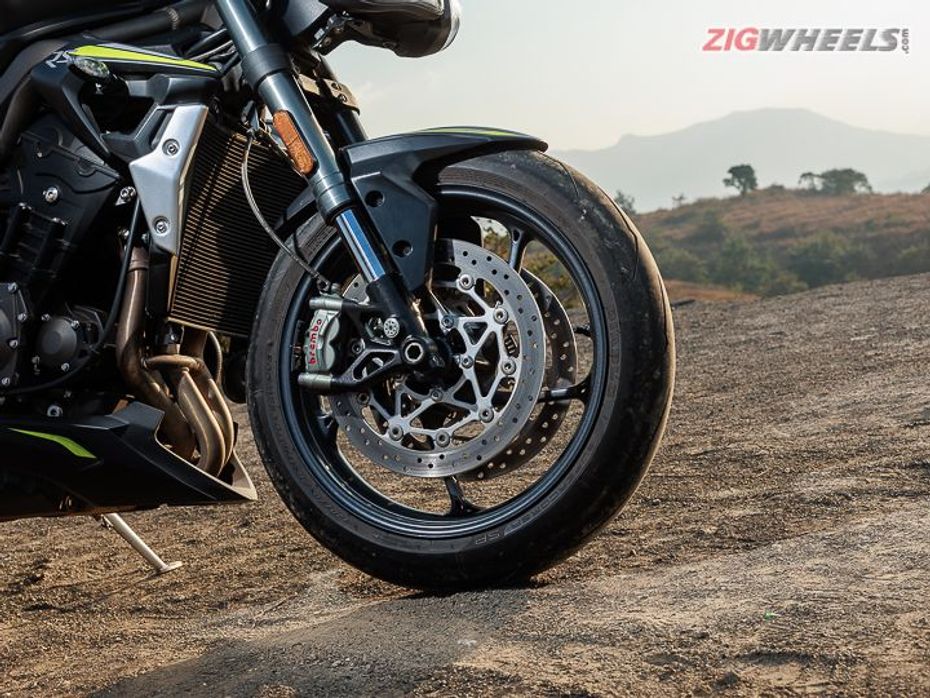
Speaking of improving your best, the STR RS’s ability to stop as quickly as it goes is just as important. Both bikes are running Brembo braking hardware but it is the STR RS that has the more advanced M50 monobloc calipers at the front (vs the M4.32 monoblocs of the Monster) and Brembo’s MCS levers that elevate the braking experience. One small tap and it is almost like hitting a brick wall. The progression is limited yet sharp. On the Monster, you are left with this feeling of longing for more feedback, the slightly spongy system doesn’t have the same ferocity and it takes a fair bit longer to come to a stop.
|
Braking |
Triumph Street Triple RS |
Ducati Monster |
|
100-0kmph |
42.86m |
44.33m |
|
60-0kmph |
15.74m |
16.09m |
The stock suspension tune on the RS is fit for cornering action, but is better suited for European or American twisties. However, on Indian roads, the stock settings hold you back a little as bumps in the middle of the corner tend to move you around a bit.
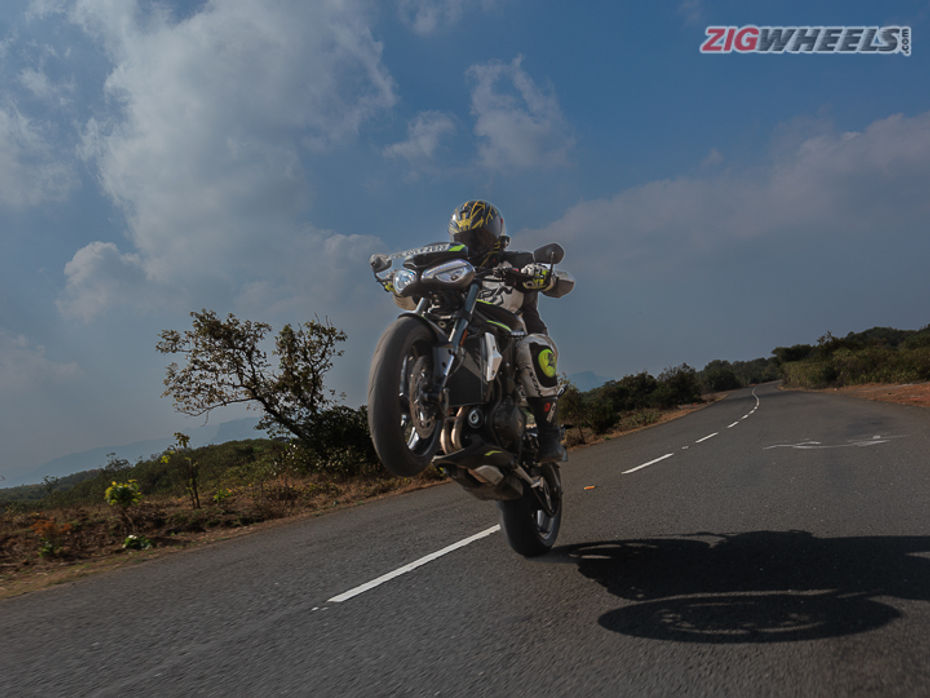
Pure Performance
These are diametrically different motorcycles at heart. The Monster is delightfully boisterous albeit with a bit of clumsiness. The RS has the manners of nobility, suave and graceful, but feels a bit studied.
|
Triumph Street Triple RS |
Ducati Monster |
|
|
Specs |
||
|
Engine |
765cc, liquid-cooled, triple |
937cc Testastretta L-twin |
|
Power |
123PS @ 11750rpm |
111.4PS @ 9250rpm |
|
Torque |
79Nm @ 9350rpm |
93Nm @ 6500rpm |
|
Acceleration |
||
|
0-60kmph |
2.07s |
2.03s |
|
0-80kmph |
2.76s |
2.70s |
|
0-100kmph |
3.44s |
3.55s |
|
0-160kmph |
7.03s |
7.68s |
The STR RS has more horses on tap but they are produced higher in the rev range, whereas the Monster has lots of torque right from 3000rpm. No wonder then that the Monster feels the livelier of the two bikes, shooting off the line with a few wheelie histrionics. But the moment you hit third gear, the RS is well and truly ahead, pulling far away into the distance, with its own skirting-off-the-tarmac wheelie.
Also, Ducati’s L-twin motors have been finetuned and smoothened out over time, refinement levels being far superior than older Monsters. But still, it isn’t a match for the Triumph triple: all of its engine vibrations have been damped and you just feel a little whirring sensation near the footpegs quite close to the rev limit.
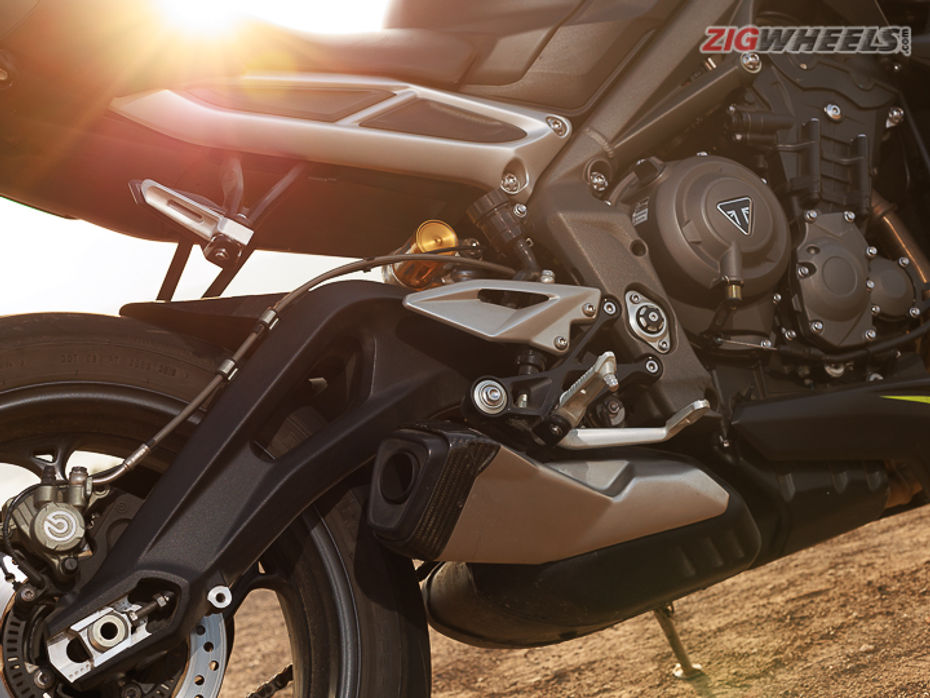
Needless to say, the triple sounds beautiful. It starts with a low grumble and goes full beast mode at 12000rpm, enough to re-energise all of your senses. Ducatistis will appreciate the mechanical symphony of the motor’s chattering valves, the pops and bangs upon aggressive downshifts and the general gruffness during hard acceleration. Each sound is unique, like Queen and Imagine Dragons. I love both, but I love Queen a bit more. And I guess, you would too.
On the flipside, the Ducati has the more complex and beautifully orchestrated electronics suite. The aids are IMU-aided with such subtle intervention that you wouldn’t even know that the system is doing its job. Triumph still hasn’t gotten on board with IMU aids for the naked, and the electronics do feel like a generation older. The system intervention feels obvious, traction control in the more conservative modes feels more apparent and the lack of an IMU becomes a bit hairy in Track ABS mode. Since rear lift mitigation goes out of the window, you end up pulling large stoppies that frighten you slightly if you never meant to execute them.
Ultimately, it turns out that even though the new Monster is pretty impressive, the Street Triple RS can hold on to its crown in the hills.
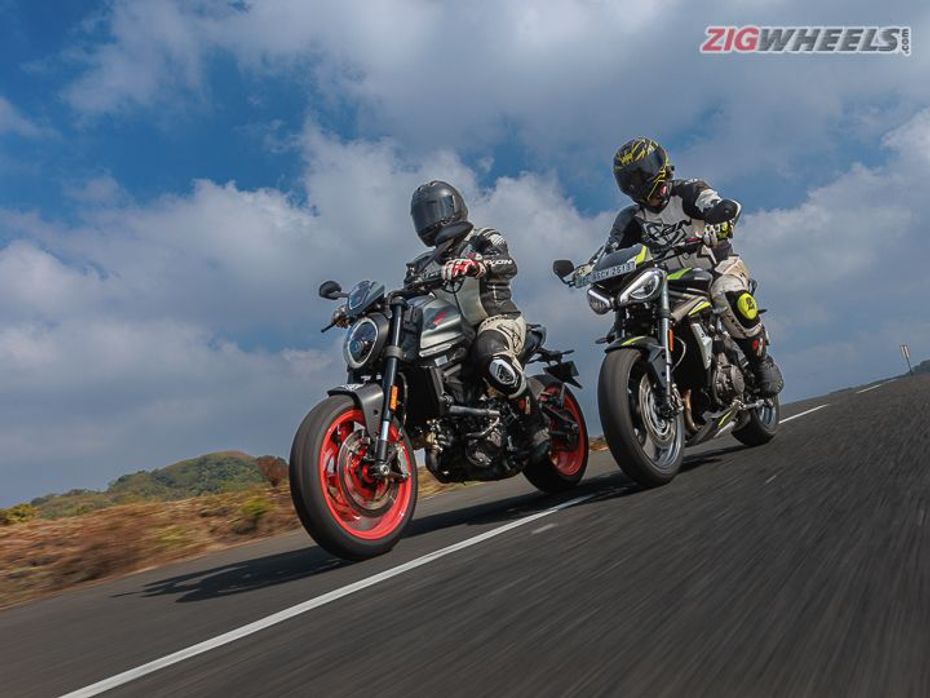
The Ride To The Twisties
Now, here’s where things start to tip into the Monster’s favour. Given the Monster’s easier ergonomics, you are settled into a nice spot for some mile munching. The STR RS makes you believe that you are riding something that is a few tweaks away from a sportbike. Hence, when you want to spend long hours in the saddle on the open road, the sportier stance does take a bit of toll on your body.
While the motor on the RS runs smoother, no buzz felt at any of the rider touchpoints, it isn’t running calmly. At 100kmph, the Monster’s larger engine is running a thousand revs lower than the triple. More so, the RS doesn’t feel satisfied maintaining speeds of 100-120kmph, always egging you to go faster. A simpler way to mitigate this would be to switch to a calmer riding mode, like Rain, or even have the customisable ‘Rider’ mode set for touring, where the engine map can be softer without having to deal with a hyper active traction control system.
Lastly, while the Pirelli Supercorsa V3s are probably the best set of rubber that one could ask for on a road bike, they aren’t built to last long. They do cost quite a bit and given the current tyre import restrictions, are very difficult to source.
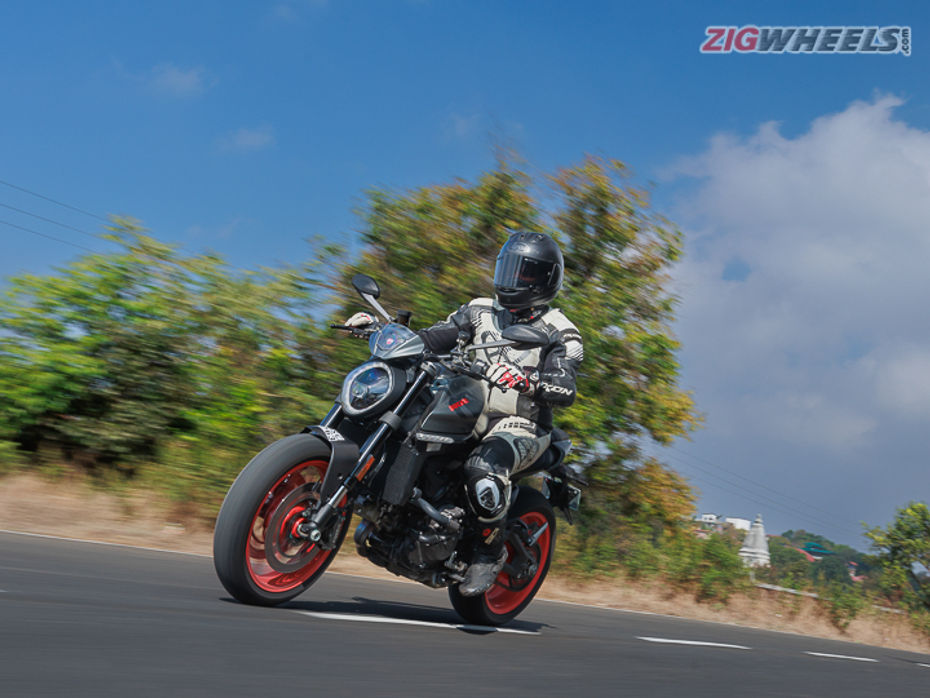
Daily Rider
Of the two, the RS has the better city focused motor. One can pull away from speeds as low as 35kmph in fifth or even 40kmph in sixth with a clean pull of the throttle. There’s no engine shudder or the feeling that you will stall the bike. It runs smoothly and the linear power delivery makes city riding a breeze.
The Monster’s Testastretta is a typical Ducati L-twin. It grumbles at low revs and cannot be ridden in higher gears in the city. There’s an easy method to find the minimum speed for each cog on the Monster -- 20 in 2nd, 30 in 3rd, 40 in 4th and so on. You have to work the gearbox a bit and it certainly doesn’t feel as polished.
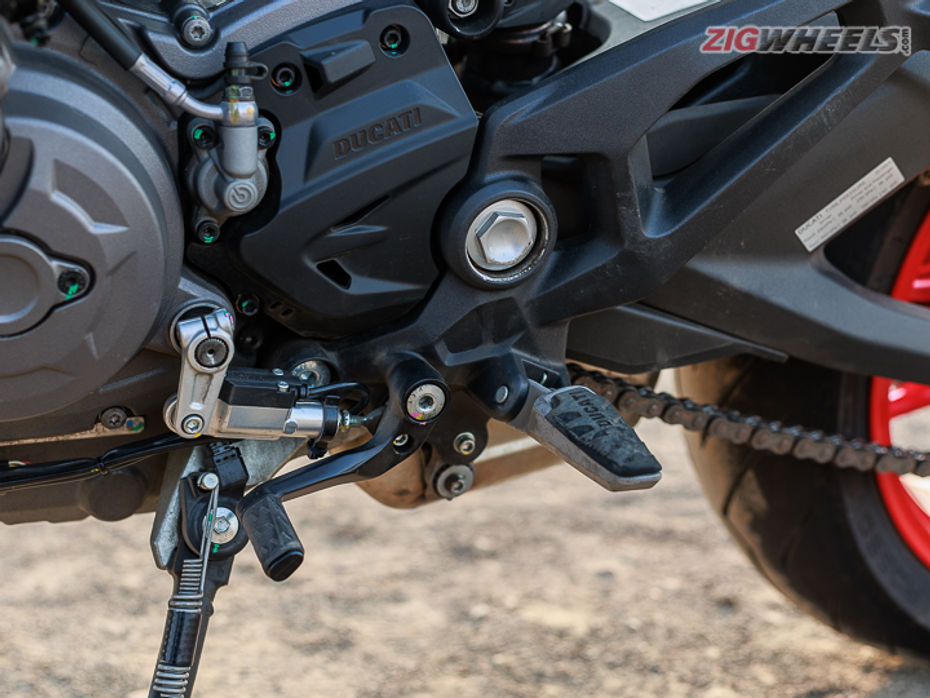
Yet, you could live with working the gearbox constantly. Thank the engineers who have calibrated the bi-directional quickshifter. It is one of the slickest in the business and it is something that Ducati has mastered. Every shift is precise, requires minimal effort and is a joy to quickly bang through the transmission. The RS also has a bi-directional quickshifter but just like the electronics suite, this aid too needs some refinement and fine calibration.
And there’s no getting over the fact that the Monster is a proper hooligan. The immediate grunt will have you leave traffic behind in a trail of dust, the light steering makes it easy to flick through vehicles and the supple ride soaks up most bumps with grace. The Triumph is a bit demanding in that manner. From the sporty riding stance to the sharper steering geometry to the firm stock suspension tune, all contribute towards the STR RS being not as easy to live with as the Monster. It isn’t a deal breaker by any stretch. It is just something that you will have to learn to adjust and live with.
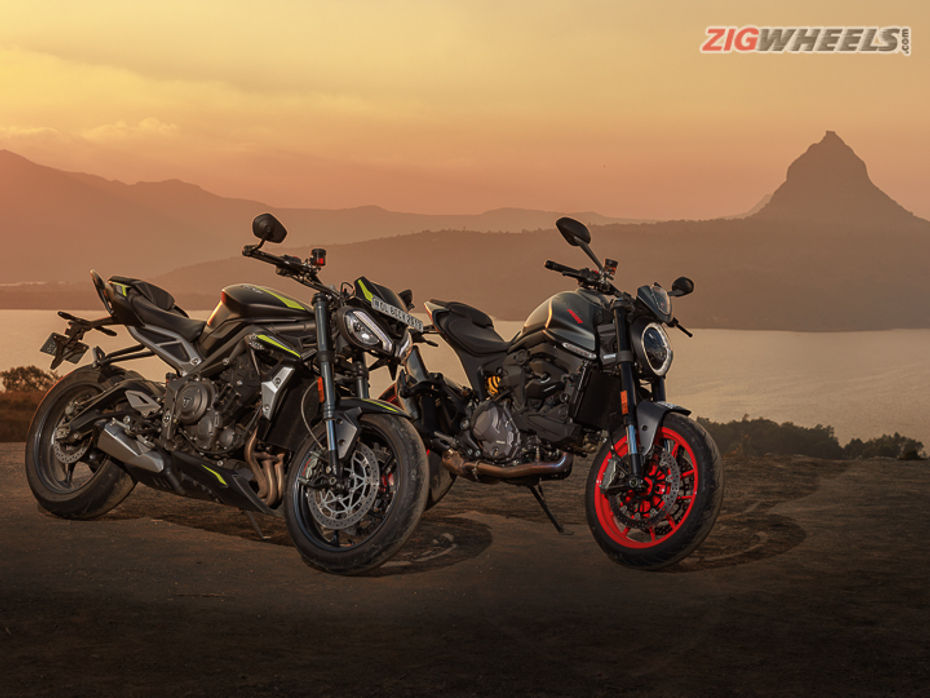
Eye Candy
To be honest, neither motorcycle is gorgeous. Triumph has been persisting with the bug eyes for ages and this iteration with the brow-type LED DRLs are certainly more bearable and nice to look at. And the Monster, well… doesn’t look like a Monster. It looks like a Brutale (or to some people in the office, a Revolt RV400).
If it is the big bike visual appeal that you seek, the RS looks the part. Right from the wider front section to the large fuel tank to the elongated tail, everything on the RS looks like it was made to feel substantial. Monsters of the past have looked big and compromised big time on the riding dynamics. It feels the other way round here where the Ducati Centro Stile has prioritised function over form.
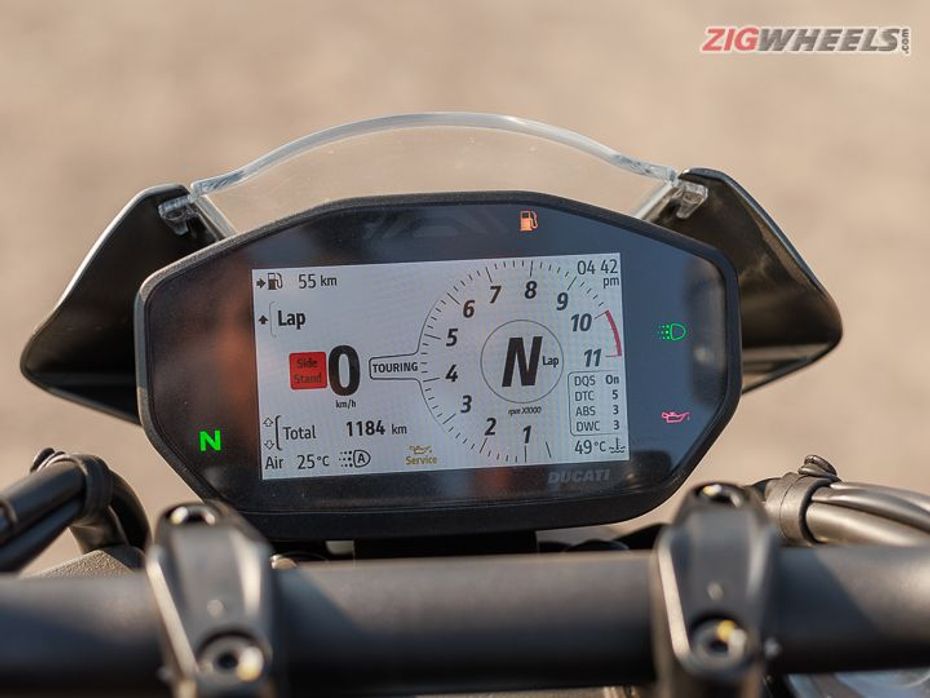
Functionally Sound
What must be commended about the Ducati designers is just how simple and effective the controls are. Switching modes isn’t a pain. Fiddling around with the electronics at standstill is quick and intuitive. And then there’s the dash. Small size but with a clean layout and crisp resolution. Every riding mode has its own dedicated colour, the tachometer goes from grey to orange and red as you rev the bike out and the main readouts are easy to spot.
The Triumph is the complete opposite. It has a pretty large colour TFT dash and loads of switches dedicated for various aspects. It takes a while to get used to the system and choosing the riding mode isn’t the most effective. More so, the four different screen layouts are drab and uninspiring.
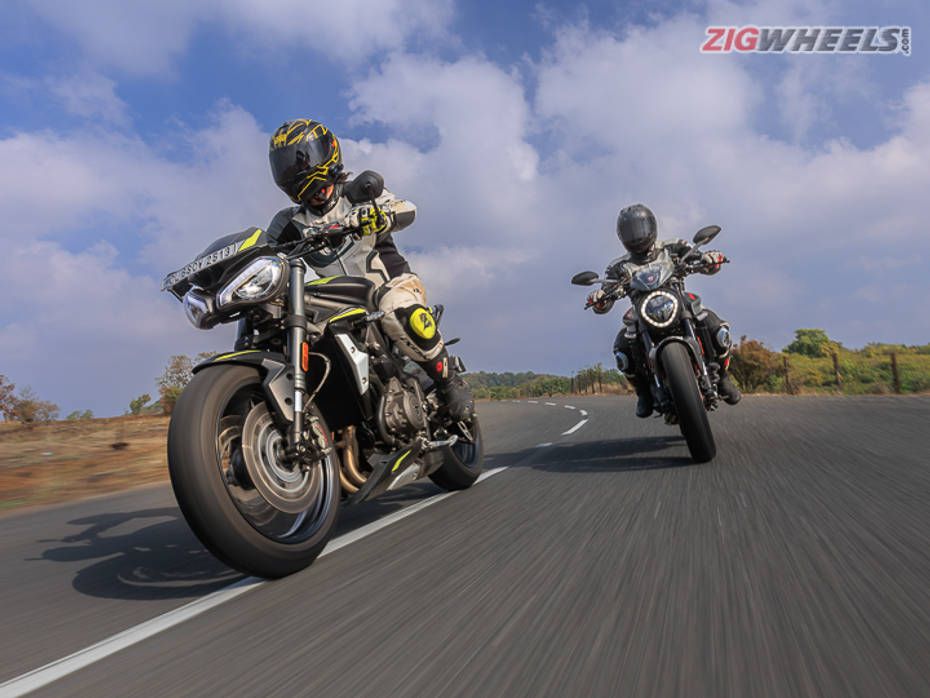
Who Takes The Crown?
It isn’t simple and straightforward. In our books, there’s no one clear winner as both motorcycles have left a lasting impression. The Monster’s brashness and youthfulness will make your heart beat faster every time you take it for a spin. It is easy and effortless. Most importantly, it is forgiving and that’s a great quality for any bike to have in our books, especially for first time big bike buyers for whom this bike is intended for.
The Street Triple RS is the king of the hills and its highway and city mannerisms aren’t too bothersome to sway buyers towards the Bolognese naked. It demands precision, it demands an experienced hand and it demands you be a thinking rider. And if you do live up to its standard, it is far more rewarding than the Monster, especially if you take it to the hills and the race track.
What makes the decision for us though has to be the asking price.
|
Triumph Street Triple |
Ducati Monster |
|
|
Ex-showroom Price |
R: Rs 9.15 lakh RS: Rs 11.35 lakh |
STD: Rs 10.99 lakh Plus: Rs 11.24 lakh |
|
On-road price |
R: Rs RS: Rs 14.40 lakh |
STD: Rs 15.35 lakh Plus: Rs 15.85 lakh |
Paying that much premium over the RS model doesn’t feel justified in our books. We would’ve accepted if the Monster was carrying a premium of Rs 1.50 lakh over the Street Triple R, not the RS.
Also, if we were actually going to recommend you buy a bike in this segment, it would be the Street Triple R. The ex-showroom asking price is significantly less, the performance compromise is just 5PS, there’s still adjustable suspension at both ends (just the monoshock is sourced from Showa and not Ohlins), it has a bi-directional quickshifter and it is running on Pirelli Diablo Rosso 2 tyres, which would turn out to be the better tyre in the long run for Indian conditions. The real miss remains the brakes as you would have to make do with the Brembo M4.32 monoblocs, as the Monster, but that’s something you can deal with.
So, in this test of the Triumph Street Triple RS and the Ducati Monster (well, the Monster Plus), we would recommend you get the Street Triple R. Only if your wallet is fatter, and your heart is stronger and wilder than your head, the Monster would do the trick.
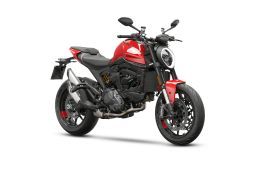

Ducati’s Monster Aims To Steal The Triumph Street Triple RS’s...

2021 Ducati Monster Review | The Monster Is Exciting Again |...

2021 Ducati Monster First Ride Review: Exciting Once Again
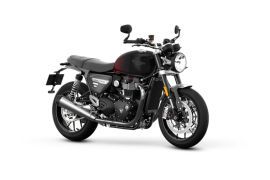 Triumph Speed Twin
Triumph Speed Twin
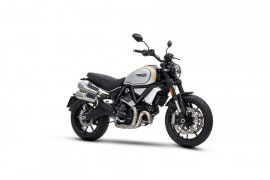 Ducati Scrambler 1100
Ducati Scrambler 1100
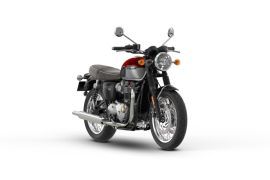 Triumph Bonneville T120
Triumph Bonneville T120
India's largest automotive community